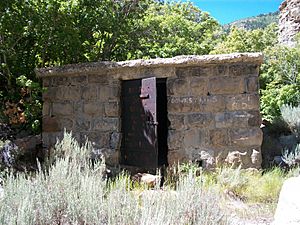Royal, Utah facts for kids
Royal is a ghost town located in Carbon County, Utah, United States. It was once a busy place in the early 1900s, built around a coal mining operation. Today, only a few old stone walls, some mine entrances, and one miner's home remain in Price Canyon.
Contents
What Was Royal?
Royal was a small community that grew because of the coal found nearby. Coal mining was a very important industry in Utah during the early 20th century. Towns like Royal were often called "company towns" because a mining company owned most of the buildings and land.
A Town with Many Names
This ghost town had several different names over its short history. It was first known as Bear Canyon. Later, it was renamed Cameron. Then, it became Rolapp. Each time a new company bought the coal mine, they changed the town's name. Finally, when the Royal Coal Company took over, the town was given its last name: Royal.
Life in a Mining Town
Life in Royal revolved around the coal mine. Miners worked hard to dig coal from the ground. Their families lived in simple homes provided by the mining company. These towns often had a company store where people could buy food and supplies. It was a tough but close-knit community.
Famous People from Royal
A well-known historian and author named Helen Z. Papanikolas was born in Royal in 1917. At that time, the town was called Cameron. She later wrote many books and articles about the history of Utah, especially focusing on the lives of immigrants and working-class people.
Why Did Royal Become a Ghost Town?
Like many mining towns, Royal eventually became a ghost town. This usually happens when the mine runs out of coal or when it becomes too expensive to dig it out. When the mining operations stopped, people moved away to find work elsewhere. Over time, the buildings fell apart, leaving behind only ruins.
Royal Today
If you visit Price Canyon today, you can see the few things left of Royal. These include some old stone foundations and the entrances to the mines. There's also one miner's dwelling that still stands, reminding us of the people who once lived and worked there. These remains tell the story of a time when coal was king in Utah.



